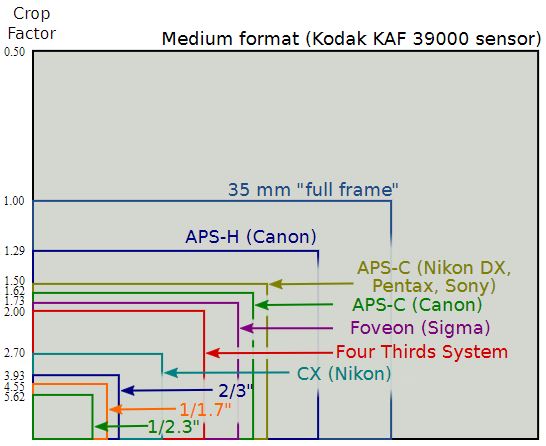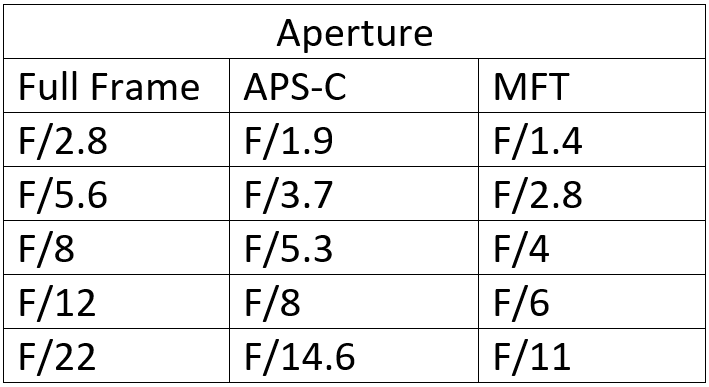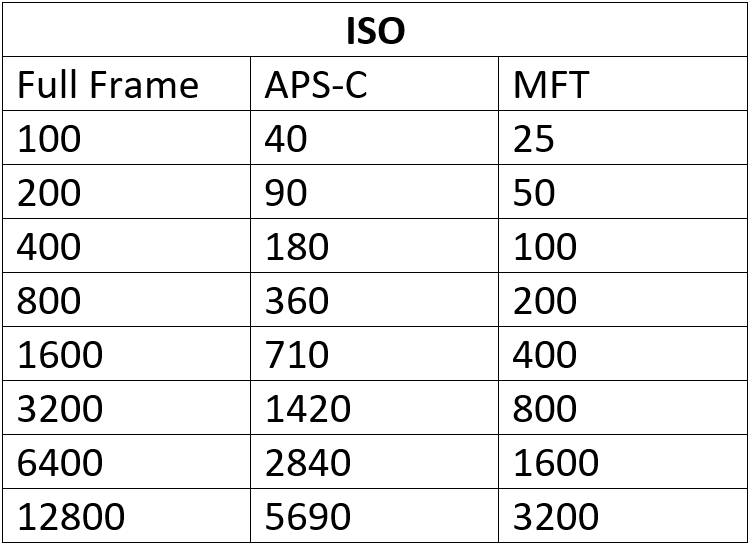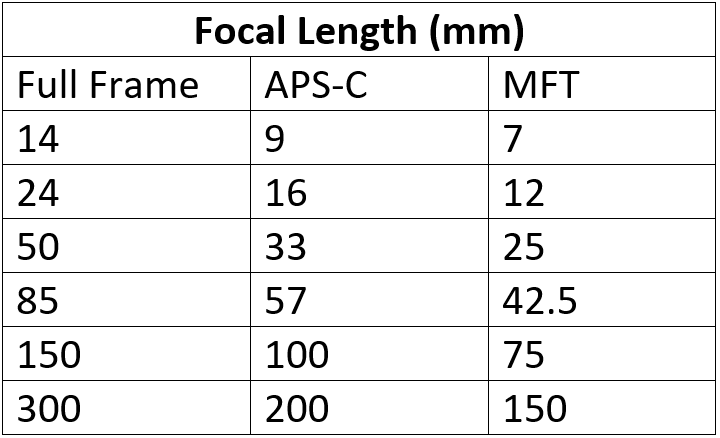The size of your camera sensor affects focal length, aperture, and ISO. The three most popular sensor sizes from smallest to largest are: Micro Four Thirds (MFT), APS-C, and Full Frame (35mm). You likely have one of these sensor sizes. Check your manual to see which sensor size your camera has. Now let’s get into the differences between sensor sizes.
Size
Bigger sensors require bigger cameras and sensors are one of the most expensive pieces of the camera. This means cameras with larger sensors will likely be more expensive and heavier. If price and weight are very important to you, a camera with a smaller sensor might be the way to go. Don’t quit reading yet though. There are more things to consider.

Crop Factor
To explain the other differences, you first need to understand crop factor. Full Frame is the photography standard. Why? Everything used to be shot on 35mm film and Full Frame digital sensors are the equivalent size. That’s it.
Luckily, converting Full Frame settings to other sensor sizes is simple and is based on the “crop factor” of the sensor. The crop factor is related to how much smaller (or larger) the sensor is than a Full Frame sensor. All you need to know is MFT has a 2.0x crop factor and APS-C has a 1.5x crop factor.

By MarcusGR – CC BY-SA 3.0
Now that we know the crop factors of different sensors, we can start converting settings. But first, you should know why you have to.
Exposure
When camera manufacturers started making different sensor sizes, they had a choice. Make settings equal in terms of depth of field and noise, or in terms of exposure. They chose exposure. That means that the same settings on different sensor sizes will result in the same exposure, but noise and depth of field will be different.
Aperture
Aperture determines depth of field (DOF). Sensor size affects how much aperture determines DOF. The same f-number on different sensors will result in the same exposure, but DOF will be different. To find out what your f-number should be to achieve the same DOF as Full Frame, simply divide the Full Frame f-number by the crop factor to determine the necessary aperture.
For example, Micro Four Thirds sensors have a crop factor of 2x. If you want the same DOF as the Full Frame setting f/2.8, your MFT setting would be f/1.4 because f/2.8 ÷ 2(MFT crop factor) = f/1.4
For more examples, check out the table below. It can be read, “To achieve the same DOF as the aperture setting f/2.8 on a Full Frame camera, f/1.9 must be used for APS-C cameras, and f/1.4 must be used for MFT cameras”.

It is important to know how to convert aperture because almost all photography information is in terms of Full Frame sensors and it often isn’t even mentioned that sensor size matters. It’s up to you to convert so you understand others and your camera. If you’ve been copying someone else’s settings and wondering why your photos are different, this could be the reason.
ISO
Sensor size affects noise for ISO. To understand why, we need to examine three facts.
1) A smaller sensor receives less total light.
2) The more light there is, the less noise.
3) ISO settings on different cameras result in the same exposure.
1) A smaller sensor receives less total light for the same reason that a smaller bucket would collect less water in a rainstorm. It is not raining less on the smaller bucket. There is just less area to collect rain. On a smaller camera sensor, there is less area to collect light than a larger sensor.
2) When more light reaches the camera sensor, ISO settings can be set lower to get correct exposure. Lower ISO settings mean less noise.
3) To understand the last fact, we first need to know what ISO is. ISO is the amount of light amplification that is applied to the signal received from the camera sensor. So, for exposure to be the same at the same setting, more light amplification must be happening. More amplification, more noise.
To find out what settings have the same amount of noise on different sensors, we need to find the settings where amplification is the same.
The conversion for noise equivalency is the crop factor squared multiplied by the ISO to get the Full Frame equivalent. For example, Micro Four Thirds sensors have a crop factor of 2x. If you set your ISO to 200, the equivalent setting for noise on a Full Frame camera would be 800 because 200 x 2(MFT crop factor)^2 = 800.
For more examples, check out the table below. It can be read, “At ISO 200 on an MFT camera, the amount of noise will be the same as ISO 360 on an APS-C camera, and the same as ISO 800 on a Full Frame camera”.

Remember that these conversions are for noise equivalency only. The same settings on different sensor sizes will result in the same exposure.
Focal Length
To convert the focal length on your lens to the Full Frame equivalent, simply multiply your lenses focal length by the crop factor of your sensor. For example, Micro Four Thirds sensors have a crop factor of 2x. If your lens has a focal length of 25mm, it would look the same as a 50mm lens on a Full Frame Camera because 25mm x 2(MFT crop factor) = 50mm Full Frame.
For more examples, check out the table below. It can be read as, “To achieve the same field of view as 14mm for Full Frame, 9mm is used for APS-C, and 7mm is used for MFT.

It is important to know your camera sensor size and how to convert focal length because lenses are sold in terms of absolute focal length. It is not relative to the sensor size. You must convert yourself. Most information about taking pictures is in terms of Full Frame cameras. You might read somewhere that 85mm is great for portraits. That information is misleading if don’t have a Full Frame sensor. You need to be able to convert that to your sensor size, so you don’t buy an 85mm lens for your MFT camera and figure out it’s way too zoomed in.
